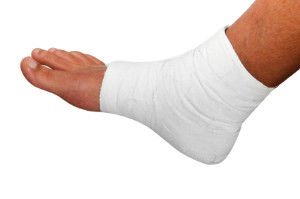
Wilmington (937) 382-2347
Fax
(513) 932-1606

Wilmington (937) 382-2347
Fax
(513) 932-1606
 Maintaining proper foot care is essential at any age, and it’s especially important for the elderly population to pay close attention to their feet. Commonly, assistance is often needed to properly trim the toenails because of eyesight concerns or experiencing difficulty in bending down. There are several steps to correctly trimming the toenails, and it’s suggested to start by soaking the feet in a warm bath to aid in softening the nails. It’s wise to thoroughly dry the feet, especially between the toes, and apply a moisturizer that will prevent the skin from cracking. Trimming the toenails straight across the nail bed can prevent ingrown toenails and infections from developing. Please schedule a consultation with a podiatrist for additional information on how to care for elderly feet.
Maintaining proper foot care is essential at any age, and it’s especially important for the elderly population to pay close attention to their feet. Commonly, assistance is often needed to properly trim the toenails because of eyesight concerns or experiencing difficulty in bending down. There are several steps to correctly trimming the toenails, and it’s suggested to start by soaking the feet in a warm bath to aid in softening the nails. It’s wise to thoroughly dry the feet, especially between the toes, and apply a moisturizer that will prevent the skin from cracking. Trimming the toenails straight across the nail bed can prevent ingrown toenails and infections from developing. Please schedule a consultation with a podiatrist for additional information on how to care for elderly feet.
Proper foot care is something many older adults forget to consider. If you have any concerns about your feet and ankles, contact Dr. Gerald Perelman from Ohio. Our doctor can provide the care you need to keep you pain-free and on your feet.
The Elderly and Their Feet
As we age we start to notice many changes in our body, but the elder population may not notice them right away. Medical conditions may prevent the elderly to take notice of their foot health right away. Poor vision is a lead contributor to not taking action for the elderly.
Common Conditions
Susceptible Infections
Diabetes and poor circulation can cause general loss of sensitivity over the years, turning a simple cut into a serious issue.
If you have any questions please feel free to contact our office located in Wilmington, OH . We offer the newest diagnostic and treatment technologies for all your foot and ankle needs.
 A common ailment that many tennis players are affected by are ankle sprains. The ligaments on the outside of the foot are weaker than those on the inside and may have difficulty in protecting the ankle if it should turn inward. You may have trouble differentiating between a sprain and a break, and it often becomes necessary to have an X-ray performed. Common symptoms may include severe pain and swelling, in addition to discoloration of the skin. Resting the foot is an important first step in healing from this injury, in addition to ceasing all activities including walking. The swelling will subside when the the foot is elevated and will generally feel better. After the recovery period begins, performing certain exercises will help the ankle to become stronger, and the tennis games can resume. One way to possibly prevent this injury is to wear proper footwear while playing tennis. Specifically, tennis shoes are designed in a way to prevent injuries. It would be advised to purchase a pair before partaking in the sport. If you think you may have sprained your ankle during a game of tennis or have any questions or concerns, scheduling an appointment with a podiatrist is advised.
A common ailment that many tennis players are affected by are ankle sprains. The ligaments on the outside of the foot are weaker than those on the inside and may have difficulty in protecting the ankle if it should turn inward. You may have trouble differentiating between a sprain and a break, and it often becomes necessary to have an X-ray performed. Common symptoms may include severe pain and swelling, in addition to discoloration of the skin. Resting the foot is an important first step in healing from this injury, in addition to ceasing all activities including walking. The swelling will subside when the the foot is elevated and will generally feel better. After the recovery period begins, performing certain exercises will help the ankle to become stronger, and the tennis games can resume. One way to possibly prevent this injury is to wear proper footwear while playing tennis. Specifically, tennis shoes are designed in a way to prevent injuries. It would be advised to purchase a pair before partaking in the sport. If you think you may have sprained your ankle during a game of tennis or have any questions or concerns, scheduling an appointment with a podiatrist is advised.
Ankle sprains are common but need immediate attention. If you need your feet checked, contact Dr. Gerald Perelman from Ohio. Our doctor can provide the care you need to keep you pain-free and on your feet.
How Does an Ankle Sprain Occur?
Ankle sprains take place when the ligaments in your ankle are torn or stretched beyond their limits. There are multiple ways that the ankle can become injured, including twisting or rolling over onto your ankle, putting undue stress on it, or causing trauma to the ankle itself.
What Are the Symptoms?
Preventing a Sprain
Treatment of a Sprain
Treatment of a sprain depends on the severity. Many times, people are told to rest and remain off their feet completely, while others are given an air cast. If the sprain is very severe, surgery may be required.
If you have suffered an ankle sprain previously, you may want to consider additional support such as a brace and regular exercises to strengthen the ankle.
If you have any questions please feel free to contact our office located in Wilmington, OH . We offer the newest diagnostic and treatment technologies for all your foot and ankle needs.
 Scientists from Baylor College of Medicine believe iberiotoxin, a toxin from the venom of the Indian red scorpion, may be able to treat rheumatoid arthritis because of the benefits it may have. Iberiotoxin has a natural ability to block potassium channels in cells. These cells are active in RA, which may damage joints and prompt immune cells to cause inflammation. This toxin may have little or no side effect, and an added benefit may be that other channels or nerves may not be affected. Knowing all of this information, researchers then tested the toxin on rat models. The results were what they were hoping for. The substance stopped the progression of the disease and improved joint mobility. Their research later went on to be published in the Journal of Pharmacology and Experimental Therapeutics.
Scientists from Baylor College of Medicine believe iberiotoxin, a toxin from the venom of the Indian red scorpion, may be able to treat rheumatoid arthritis because of the benefits it may have. Iberiotoxin has a natural ability to block potassium channels in cells. These cells are active in RA, which may damage joints and prompt immune cells to cause inflammation. This toxin may have little or no side effect, and an added benefit may be that other channels or nerves may not be affected. Knowing all of this information, researchers then tested the toxin on rat models. The results were what they were hoping for. The substance stopped the progression of the disease and improved joint mobility. Their research later went on to be published in the Journal of Pharmacology and Experimental Therapeutics.
Because RA affects more than just your joints, including the joints in your feet and ankles, it is important to seek early diagnosis from your podiatrist if you feel like the pain in your feet might be caused by RA. For more information, contact Dr. Gerald Perelman of Ohio. Our doctor will assist you with all of your podiatric concerns.
What Is Rheumatoid Arthritis?
Rheumatoid Arthritis (RA) is an autoimmune disorder in which the body’s own immune system attacks the membranes surrounding the joints. Inflammation of the lining and eventually the destruction of the joint’s cartilage and bone occur, causing severe pain and immobility.
Rheumatoid Arthritis of the Feet
Although RA usually attacks multiple bones and joints throughout the entire body, almost 90 percent of cases result in pain in the foot or ankle area.
Symptoms
Diagnosis
Quick diagnosis of RA in the feet is important so that the podiatrist can treat the area effectively. Your doctor will ask you about your medical history, occupation, and lifestyle to determine the origin of the condition. Rheumatoid Factor tests help to determine if someone is affected by the disease.
If you have any questions please feel free to contact our office located in Wilmington, OH . We offer the newest diagnostic and treatment technologies for all your foot and ankle needs.
 Permanent damage to your feet may be a result of wearing high heels frequently and throughout the day. There are several parts of the feet that may suffer afflictions, starting with the toes. You may see a deformity that may gradually develop, due to the feet being in an environment that’s too small. Additionally, calf muscles may shorten because the stride is not as long as it would be with flatter shoes. Hammertoes, bunions, or sprained ankles are among the many ailments that can develop from wearing high heels daily, and if severe enough, may require surgery. If you do choose to wear high heels, try to limit the length of the heel and select a shoe with a wide area for the toes.
Permanent damage to your feet may be a result of wearing high heels frequently and throughout the day. There are several parts of the feet that may suffer afflictions, starting with the toes. You may see a deformity that may gradually develop, due to the feet being in an environment that’s too small. Additionally, calf muscles may shorten because the stride is not as long as it would be with flatter shoes. Hammertoes, bunions, or sprained ankles are among the many ailments that can develop from wearing high heels daily, and if severe enough, may require surgery. If you do choose to wear high heels, try to limit the length of the heel and select a shoe with a wide area for the toes.
High heels have a history of causing foot and ankle problems. If you have any concerns about your feet or ankles, contact Dr. Gerald Perelman from Ohio. Our doctor can provide the care you need to keep you pain-free and on your feet.
Effects of High Heels on the Feet
High heels are popular shoes among women because of their many styles and societal appeal. Despite this, high heels can still cause many health problems if worn too frequently.
Which Parts of My Body Will Be Affected by High Heels?
What Kinds of Foot Problems Can Develop from Wearing High Heels?
How Can I Still Wear High Heels and Maintain Foot Health?
If you want to wear high heeled shoes, make sure that you are not wearing them every day, as this will help prevent long term physical problems. Try wearing thicker heels as opposed to stilettos to distribute weight more evenly across the feet. Always make sure you are wearing the proper shoes for the right occasion, such as sneakers for exercising. If you walk to work, try carrying your heels with you and changing into them once you arrive at work. Adding inserts to your heels can help cushion your feet and absorb shock. Full foot inserts or metatarsal pads are available.
If you have any questions please feel free to contact our office located in Wilmington, OH . We offer the newest diagnostic and treatment technologies for all your foot and ankle needs.